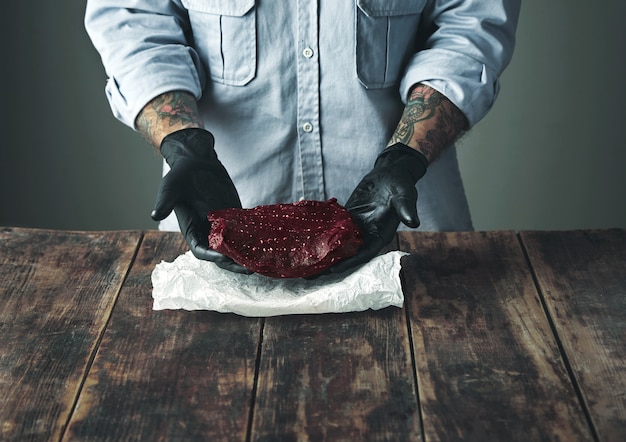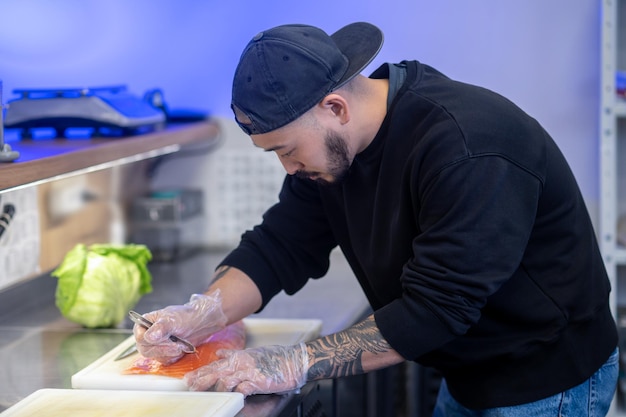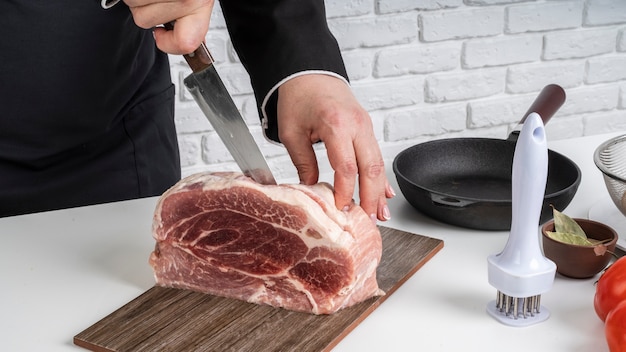Let's be honest, cooking a steak that's perfectly tender and juicy can feel like a culinary tightrope walk. You're balancing the risk of overcooking, leading to a dry, tough steak, with the fear of undercooking, leaving you with a raw centre. For years, I felt like a steak novice, constantly chasing that elusive "perfectly cooked" result. Then, I discovered sous vide cooking – and let me tell you, it was a game-changer!
It's not just about achieving restaurant-quality results; it's about taking the stress out of steak cooking and leaving you with a consistently delicious, satisfying meal. This article is your comprehensive guide to mastering the sous vide method for steak. From selecting the right cut to achieving that flawless sear, I'm sharing everything I've learned, along with personal tips and tricks that have helped me achieve steak nirvana.
(Part 1) Unveiling the Magic of Sous Vide Cooking

Sous vide, meaning "under vacuum" in French, is a cooking technique that involves sealing food in a vacuum-sealed bag and then immersing it in a precisely controlled water bath. The magic of sous vide lies in its ability to cook food evenly at a specific temperature. This consistent heat penetration ensures that every part of your steak is cooked to your exact preference, resulting in melt-in-your-mouth tenderness and perfect juiciness.
It's like a personal chef in your kitchen, meticulously controlling the cooking process, eliminating the guesswork and anxiety that often comes with traditional steak cooking. The first time I cooked a steak sous vide, I was astonished by the result – no more dry, overcooked edges or raw centres, just pure, tender perfection. It was a revelation, and I knew I had to share this with the world!
The benefits of sous vide steak: A Culinary Revolution
Why should you embrace the sous vide method for your steak? The benefits speak for themselves:
- Tenderness and Juiciness Beyond Compare: Goodbye, dry, tough steak! Sous vide ensures that your steak is cooked to the perfect level of tenderness, with every bite bursting with juicy flavour. Think melt-in-your-mouth heaven.
- Unwavering Consistency: Say goodbye to inconsistent results! Whether you're a seasoned cook or a kitchen newbie, sous vide delivers perfectly cooked steak every single time. No more surprises, just pure satisfaction.
- Precision at Your Fingertips: With sous vide, you control the exact temperature, ensuring your steak is cooked to your precise preference. It's like having a personal chef setting the ideal temperature for you.
- Hands-Free Cooking: Set it and forget it! Once your steak is in the water bath, you can relax and focus on other tasks. It's the perfect solution for busy nights or when you want to spend less time in the kitchen and more time enjoying your delicious meal.
- Elevate Your Sear: Because sous vide pre-cooks your steak to the perfect level of doneness, you can dedicate your full attention to achieving that sensational sear. With a hot grill or cast iron skillet, you can create a beautiful, crispy crust that complements the tender interior.
(Part 2) Equipping Your Kitchen for Sous Vide Steak Success

Now that you're ready to dive into the world of sous vide steak, let's talk equipment. You don't need a gourmet kitchen to achieve stellar results. Here's what you'll need to embark on your sous vide journey:
1. The Sous Vide Cooker: Your Culinary Thermostat
The heart of sous vide cooking is the sous vide cooker. Essentially, it's a water bath with a precise temperature control system that ensures your food cooks at a consistent temperature. Sous vide cookers come in various price points and features, from basic immersion circulators to more advanced models with Wi-Fi connectivity. I started with a basic immersion circulator, and it worked wonders for me, but if you're looking for extra features, there are options out there.
2. Vacuum Sealer: Sealing in Flavor and Tenderness
To create an airtight seal that prevents the steak from getting waterlogged and allows for even cooking, you'll need a vacuum sealer. They come in manual and automatic models, depending on your preference and budget. While a manual model will work just fine, an automatic sealer can be a real time-saver, especially if you plan to use sous vide frequently.
3. Heavy-Duty Freezer Bags: The Sous Vide Kitchen Workhorse
While regular freezer bags can be used, I highly recommend investing in heavy-duty freezer bags specifically designed for sous vide. These bags are thicker and less prone to tearing or leaking, ensuring a secure seal during cooking. They're also reusable, making them a wise investment in the long run.
4. Kitchen Thermometer: Double-Checking for Perfection
While your sous vide cooker maintains a precise temperature, having a kitchen thermometer on hand to double-check the water bath temperature is a good idea, especially when you're first starting out. It's always better to be safe than sorry!
5. Cast Iron Skillet or Grill: The Finishing Touch
After your steak is cooked to perfection in the water bath, it's time to give it that final touch – the sear. A blazing hot cast iron skillet or grill is the ideal way to create a beautiful, crispy crust. These tools heat up quickly and distribute heat evenly, ensuring a consistent sear that complements the tender interior of your steak.
(Part 3) Selecting the perfect steak: A Cut Above the Rest

Now, let's get to the heart of the matter – choosing the right steak. You can cook almost any cut of steak using sous vide, but some cuts are more ideal for this method due to their marbling, tenderness, and flavour profile. Here are some of my personal favourites for sous vide cooking:
1. new york strip: A Steak Classic
Known for its beautiful marbling and rich flavour, the New York strip is a classic steak choice. It cooks evenly and maintains its juicy tenderness, making it a perfect candidate for sous vide. It's my go-to cut for special occasions and when I want to impress my guests.
2. Ribeye: Indulgent and Flavorful
Another crowd-pleasing cut, ribeye is renowned for its buttery tenderness and intense flavour. It's a great choice if you're seeking a truly indulgent steak experience, perfect for a casual Friday night dinner or a weekend barbecue.
3. filet mignon: Delicate and Exquisite
This delicate cut is known for its exceptional tenderness and mild flavour. It's a perfect choice for a romantic dinner or a special occasion. Keep in mind that filet mignon is thinner than other cuts, so you'll want to adjust cooking times accordingly.
4. Sirloin: A Versatile and Affordable Choice
A more budget-friendly option, sirloin is a leaner cut with a good amount of flavour. It's an excellent choice for a weeknight dinner when you crave a juicy and satisfying steak without breaking the bank.
5. flank steak: Flavorful and Versatile
Known for its robust flavour and versatility, flank steak is a fantastic choice for marinating and grilling. The longer cooking time in the sous vide bath helps tenderize it, making it perfect for a summer barbecue.
(Part 4) Preparing Your Steak for Sous Vide Perfection
While sous vide simplifies the cooking process, a little preparation goes a long way in ensuring a truly exceptional steak. Here's a step-by-step guide to get your steak ready for its sous vide journey:
1. Pat Dry for a Crisp Crust:
Start by patting your steak dry with paper towels. This removes excess moisture, which can prevent a crisp crust during searing.
2. Seasoning Secrets for Enhanced Flavor:
Salt and pepper are the essential seasonings for steak. For a flavour explosion, salt your steak liberally about 30 minutes before cooking. This allows the salt to penetrate the meat, drawing out moisture and creating a more flavourful crust.
3. Airtight Sealing: Locking in Tenderness
Now, it's time for your vacuum sealer. Place your seasoned steak in a heavy-duty freezer bag and use the vacuum sealer to remove all the air. This creates an airtight seal that prevents the steak from getting waterlogged, ensuring even cooking and preserving the natural juices. If you don't have a vacuum sealer, don't worry! You can use a zip-lock bag and displace the air by submerging the bag in a bowl of water. Just make sure to seal the bag tightly!
4. Adding Aromatics (Optional): A Symphony of Flavors
For an extra burst of flavour, you can add aromatics to the bag. Herbs like thyme, rosemary, and garlic can infuse the steak with delightful aromas. Be creative and experiment with different flavour combinations!
(Part 5) The Sous Vide Cooking Process: A Culinary Symphony
Now, the exciting part! Let's walk through the sous vide cooking process, step by step:
1. Filling the Water Bath: A Calm and Steady Pool
Fill a large pot with water, ensuring there's enough space to fully submerge the vacuum-sealed bag. You want the water to cover the bag completely, ensuring even heat distribution.
2. Setting the Temperature: Precision is Key
This is where you choose your desired doneness. Remember, sous vide allows you to cook your steak to the exact temperature you prefer. Here's a handy table with recommended temperatures for different levels of doneness:
| Doneness | Temperature (°F) |
|---|---|
| Rare | 125-129 |
| Medium-Rare | 130-135 |
| Medium | 135-140 |
| Medium-Well | 140-145 |
| Well-Done | 145-150 |
It's always a good idea to use a digital thermometer to check the internal temperature of the steak, especially when you're first starting out. This ensures you achieve your desired doneness.
3. Immersion Time: Patience is a Virtue
Gently submerge the vacuum-sealed bag of steak into the water bath, making sure it's fully immersed. The cooking time will depend on the thickness of your steak. Here's a general guideline:
- 1-inch thick steak: 1-1.5 hours
- 1.5-inch thick steak: 1.5-2 hours
- 2-inch thick steak: 2-2.5 hours
For a more well-done steak, you can always add a few minutes to the cooking time. Remember, patience is key! Allow the steak to cook slowly and evenly in the water bath.
(Part 6) Achieving the perfect sear: The Final Flourish
After your steak has reached the perfect level of doneness in the water bath, it's time to create a beautiful, crispy crust with a satisfying sear. Here's how to make it happen:
1. Preheating for Maximum Heat:
Whether you're using a cast iron skillet or a grill, make sure to preheat it to high heat. It should be smoking hot for that perfect sear.
2. Patting Dry for Optimal Browning:
Remove the steak from the water bath and pat it dry with paper towels. This ensures that the steak browns properly and doesn't steam instead of sear.
3. Searing Time: A Touch of Fire
Place the steak on the preheated surface and cook for 1-2 minutes per side. Don't overcook it; we just want to create a beautiful crust.
4. Rest Time: Allowing the Juices to Redistribute
Once the steak is seared to your liking, remove it from the heat and let it rest for at least 5-10 minutes before slicing and serving. This allows the juices to redistribute throughout the steak, ensuring a tender, juicy, and flavourful bite.
(Part 7) Serving Your Sous Vide steak masterpiece
The moment you've been waiting for – serving your perfectly cooked sous vide steak! Here's how to elevate your meal to new heights:
1. side dishes: A Culinary Symphony
Pair your steak with delicious side dishes that complement its rich flavour. Roasted vegetables, mashed potatoes, creamy polenta, or a fresh salad are all excellent choices. You can even add a touch of sweetness with a fruit compote.
2. Sauces: A Touch of Elegance
A good sauce can elevate your steak to new levels of deliciousness. Consider classic options like béarnaise sauce, red wine sauce, or a creamy mushroom sauce. For something bolder, try a chimichurri sauce or a spicy peppercorn sauce.
3. Wine Pairing: A Perfect Match
Enhance your dining experience with a wine that complements the flavour of your steak. A full-bodied Cabernet Sauvignon or Zinfandel will pair well with a ribeye, while a lighter Pinot Noir or Merlot would be a good choice for a filet mignon.
(Part 8) Tips and Tricks for Sous Vide Steak Success
Over the years, I've picked up some valuable tips and tricks to enhance my sous vide steak experience. Here are a few secrets to elevate your culinary game:
1. Digital Thermometer: Your Steak's Personal Guide
While your sous vide cooker does an excellent job maintaining a precise temperature, using a digital thermometer to check the internal temperature of the steak is always a good idea, especially when you're first starting out. This ensures that your steak is cooked to your exact preference, eliminating any guesswork.
2. Don't Overcook: The Art of Timing
Sous vide cooking is all about precision. It's easy to overcook the steak if you leave it in the water bath for too long. Be sure to check the temperature regularly and remove the steak when it reaches your desired doneness.
3. A Touch of Fat: Enhancing Flavor and Tenderness
Adding a small amount of butter or oil to the vacuum-sealed bag can enhance the flavor and tenderness of your steak. It also helps to prevent the steak from sticking to the bag during cooking.
4. Clean Water Bath: Hygiene is Key
It's a good practice to clean the water bath after each use. This helps to prevent bacteria from growing, ensuring that your steak is cooked in a clean and sanitary environment.
(Part 9) Sous Vide steak faqs: Unlocking the Mystery
Let's address some common questions about sous vide steak cooking to clear any lingering doubts you might have:
1. Can I Reuse Vacuum-Sealed Bags?
Yes, you can reuse the bags a few times as long as they are in good condition and haven't been punctured. Just be sure to wash them thoroughly before using them again.
2. Can I Cook Other Foods Using Sous Vide?
Absolutely! Sous vide cooking is a versatile technique that can be used for a wide range of foods, including chicken, fish, vegetables, and eggs. You can even use it to cook desserts like cheesecake!
3. How Long Can I Store Cooked Steak?
You can store the cooked steak in the refrigerator for up to 3 days. Reheat it thoroughly before serving. You can also freeze it for up to 3 months.
4. Is Sous Vide Cooking Safe?
Yes, sous vide cooking is a safe method. The high heat of the water bath kills bacteria and ensures that the food is cooked to a safe temperature. However, it's always crucial to practice good food safety habits, like washing your hands thoroughly and using a clean cutting board.
5. What if I Don't Have a Vacuum Sealer?
While a vacuum sealer is highly recommended, you can still achieve great results using a zip-lock bag. Simply displace the air from the bag by submerging it in a bowl of water, ensuring a tight seal. You can also use the “water displacement” method, where you submerge the bag in water and press out the air by pushing it towards the corner of the bag before sealing it.
I hope this comprehensive guide has inspired you to explore the wonderful world of sous vide steak cooking. It's a rewarding journey that unlocks the potential for consistently delicious, perfectly cooked steaks. Happy cooking, and enjoy the tender, juicy perfection!
Everyone is watching

Corn on the Cob: The Ultimate Guide to Perfectly Cooked Ears
Healthy MealsAh, corn on the cob. Just the name evokes images of sunny days, barbecues, and that sweet, juicy flavour that ...

Perfect Pork Roast Oven Cooking Time: A Guide to Delicious Results
Healthy MealsThere's something truly satisfying about a perfectly roasted pork. The aroma alone is enough to make your mout...

Ham Cooking Time: How Long to Bake, Smoke, or Boil a Delicious Ham
Healthy MealsAh, ham. It's a classic, isn't it? A real crowd-pleaser, especially around holidays. And when done right, it'...

Scallops: The Ultimate Guide to Perfect Cooking
Healthy MealsAh, scallops. Those delicate, sweet, and utterly delicious morsels of the sea. They hold a special place in my...

Spaghetti Squash: The Ultimate Guide to Cooking and Serving
Healthy MealsRemember that time you saw spaghetti squash at the supermarket, looking all bumpy and strange, and thought, "W...
